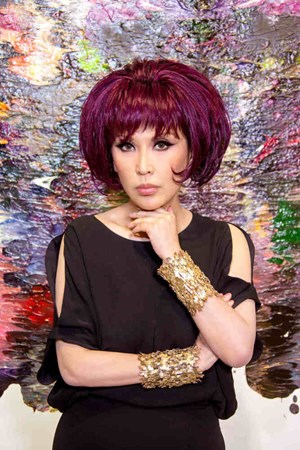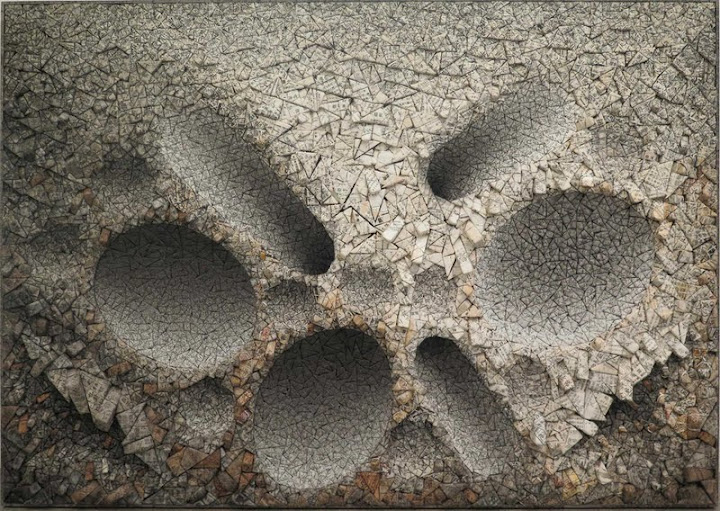
Pearl Lam, one of the most powerful women in Asian business and one of artnet news' top twenty-five women in the art world, has worked for over two decades towards promoting Chinese contemporary art worldwide. Born in Hong Kong, China, and educated in the United States and the United Kingdom, Pearl Lam herself embodies the conjunction of Western and Chinese cultures.
Pearl Lam, one of the most powerful women in Asian business and one of artnet news' top twenty-five women in the art world, has worked for over two decades towards promoting Chinese contemporary art worldwide. Born in Hong Kong, China, and educated in the United States and the United Kingdom, Pearl Lam herself embodies the conjunction of Western and Chinese cultures.
Pearl Lam’s interest in contemporary art came through design, which is the focus of one of her three galleries, located in Singapore, Hong Kong, and Shanghai. Lam’s galleries aim to stimulate further the international dialogue between regions by introducing Chinese art to the world and bringing Western art to local collectors. As one of the commissioners of movement for rapprochement between the West and China, Pearl Lam contributes to the cultural exchange through participation on an international level. This year, Lam’s galleries participate for the first time with EXPO Chicago and Sydney Contemporary. In this interview, Pearl Lam talks with Artdependence Magazine about her thoughts on the present Chinese market for contemporary art, China’s interaction with the world, and her own model of cross-cultural artistic exchange.
Artdependence Magazine: How would you define the Asian art scene and art market at the moment? Can it still be considered as the fastest growing contemporary art market in the world?
Pearl Lam: Asia is a huge entity which consist of many countries. I am lucky to have gallery spaces in key territories: Shanghai, Hong Kong and Singapore. I think the art scenes of these regions have grown more mature over the past two decades, and buyers and sellers now see the Asian market less as an emerging market. While buyers and sellers are still coming to Asia, people are also becoming more interested in South America.
I think in Hong Kong, the cultural scene is booming across the whole city. The city has become the third largest art market after London and New York in recent years, and we are absolutely confident in the art market there. The freedom that comes with trading art without import tax is a key factor for encouraging more international artists, collectors and curators to come to Hong Kong. I have watched the city gradually transform into a contemporary art hub attracting both an international and local audiences to experience Asian art.
In Shanghai, the contemporary art scene has grown fast over the last 10 years, building on the infrastructure that the Shanghai Biennial encouraged with its instigation in 1996. The city is now firmly placed on the international art map. We have world class museums, districts like M50, the Bund and a number of private museums in Shanghai, and these have really helped expose the public to contemporary art, as well as educate local collectors who are just beginning to explore the contemporary art world. As for Singapore, the collectors’ interests and tastes are evolving too, and they have started to increasingly collect art from across the globe as well as, of course, focusing on art from across South East Asia.
I am not sure if it means a lot to say that the Asian art scene is the fastest growing. In general we can say that the Asian art scene is very healthy and we are very confident in it.

Ben Quilty Identity is a first world problem, 2014. Oil on linen. 190 x 280 cm. Courtesy of the artist and Pearl Lam Galleries
AD: You have galleries in Hong Kong, Shanghai and Singapore. Do you have the same approach for each gallery?
PL: Yes – our work in different regions is directed by the same ethos: we have a unique gallery model committed to encouraging cross-cultural exchange, and we dedicate ourselves to championing artists who re-evaluate and challenge perceptions of cultural practice from each region. We try our best to stimulate international dialogue on Chinese and Asian contemporary art. At the same time that our Shanghai space focuses more on Chinese art, in Hong Kong we are dedicated to both Chinese and international art, giving some international artist their first presence in Asia and in Singapore, and providing more opportunities for Southeast Asia artists.
AD: Has there been a change in the trend in which local clients prefer local artists?
PL: We have artists from around the world exhibiting in our gallery spaces in Hong Kong, Shanghai, and Singapore. We also participate in different art fairs, such as EXPO CHICAGO and Sydney Contemporary, taking place in September this year. We bring Western artists to Asia and we also introduce Asian artists to the West. I think it is important for clients to be exposed to artists from different places and we encourage them to look beyond their own regions.

Choi Jeong Hwa Alchemy, 2015. Acrylic bowl, steel frame, LED lamp, chrome coating. H 200–220 x Ø 33 cm. Courtesy of Pearl Lam Galleries, Photography: Yaffa Meskell
AD: What will be your role at EXPO CHICAGO and what are the strengths of this fair?
PL: We are exhibiting at an art fair in the United States for the first time this year. We are one of the few participating Asian galleries at EXPO CHICAGO, and this is obviously a unique opportunity for us to introduce our artists to a wider audience. We are presenting works by 18 artists from different regions, including American artist Jenny Holzer and Chicago-born Puerto Rican artist Carlos Rolón/Dzine, alongside works by Chinese artists Qin Yufen, Su Xiaobai, Zhu Jinshi, and top Australian artist Ben Quilty. Quilty is one of the single most important artists living and working in Australia, and this will be the first time his works are on show in the US. We are also presenting a public site-specific installation, Alchemy (2015), by Korean artist Choi Jeong Hwa at The Peninsula Chicago. We believe EXPO CHICAGO will bring new opportunities to generate dialogues on contemporary art between the US and Asia.
AD: Could you name the most promising artists you work with? What are your personal artistic preferences?
PL: Abstract has always been my favorite, I have always liked art that does not look like anything, but I can’t give you a reason for that, I don’t know why that is. I also like the movement of Chinese calligraphy.
I can name one artist whom I have recently worked with and who impresses me deeply. I really love Leonardo Drew’s work. I was introduced to him by another artist. Ever since I saw his work I liked it, and since I met him I liked his work even more. I am so happy we are opening a show of his work in November, it will be a truly dynamic show.

Gonkar Gyatso 13,572 Prayers, 2015. Stickers and oil based markers on treated fine art paper. 154 x 154 cm. Courtesy of Gonkar Gyatso and Pearl Lam Galleries
AD: What about the difference in preferences between your foreign and local clients?
PL: Collectors, as well as artists, are more exposed to art from different parts of the world and become more accepting of works from emerging countries or by emerging artists. Naturally, they pay more attentions to artists from their region, but now I would say that everybody is more aware of good art, regardless of its origin and the artist’s nationality.
AD: Are you a collector yourself? And if yes, what are the principles by which you guide your collection? Is the investment factor important to you?
PL: I do collect and I buy and collect art that I love. I have been focusing on Chinese contemporary art, and as one of the very first gallerists promoting Chinese contemporary art (especially abstract art internationally) I am really excited to see the recognition it has received today. My work brings me huge enjoyment which is invaluable and non-measureable . I have been fortunate to be able to contribute to the development of the Asian art scene in the past 20 years, and I’m still enjoying it.

Jenny Holzer Truisms: Money Creates Taste, 2013. White marble bench. 43 x 155 x 65 cm. Courtesy of Pearl Lam Galleries, © 2013 Jenny Holzer, member of Artist Rights Society, Photography: Collin LaFleche.
AD: What are your commitments for the future? Are there any plans you would like to share with Artdependence Magazine?
PL: We always look for opportunities to organize contemporary art programmes that are relevant. From our galleries in Hong Kong, Singapore and Shanghai, we support and enhance the art scene at a local level, while also engaging in regional and international activities. For example, this year we are joining EXPO CHICAGO for the first time, and we are part of this year’s Sydney Contemporary. We have opened a second gallery space in Hong Kong this year, and we are looking forward to working with emerging artists in this new space in one of Hong Kong’s most vibrant and fast-developing areas. I would also like to continue to work with international artists, bringing their work to Asia.
Portait above: Pearl Lam, Founder of Pearl Lam Galleries. Courtesy of Pearl Lam Galleries, Photography: William Louey

Kwang Young Chun Aggregation 09 – JL037, 2009. Mixed media with Korean Mulberry paper. 90 x 131 cm. Courtesy of Pearl Lam Galleries and Kwang Young Chun Studio

Zhu Jinshi Brilliant, 2013. Oil on canvas. 180 x 160 cm. Courtesy of Pearl Lam Galleries

Qin Yufen Flight of Colours 2, 2014. Mineral pigment on Xuan paper. 250 x 200 cm. Courtesy of Pearl Lam Galleries

ArtDependence Magazine is an international magazine covering all spheres of contemporary art, as well as modern and classical art.
ArtDependence features the latest art news, highlighting interviews with today’s most influential artists, galleries, curators, collectors, fair directors and individuals at the axis of the arts.
The magazine also covers series of articles and reviews on critical art events, new publications and other foremost happenings in the art world.
If you would like to submit events or editorial content to ArtDependence Magazine, please feel free to reach the magazine via the contact page.